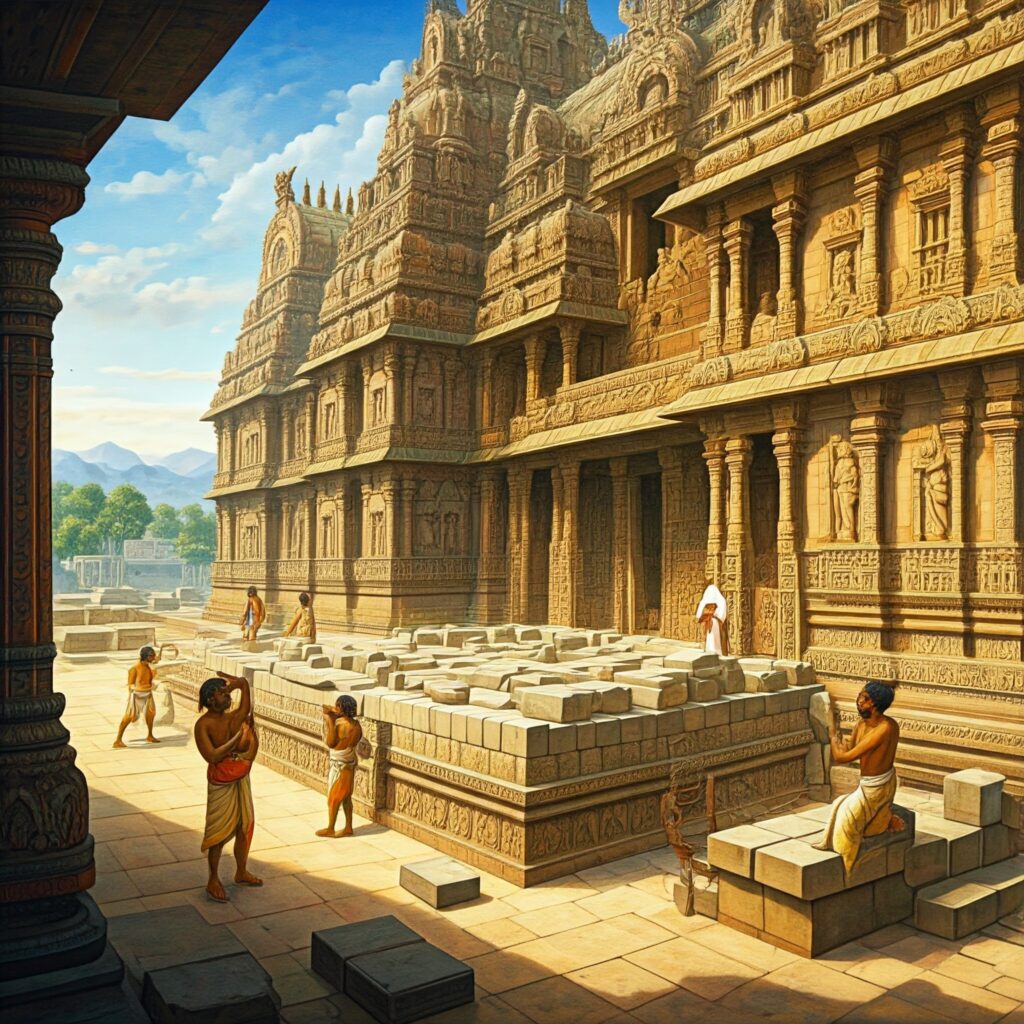
🧭 Introduction: A Timeless Spiritual Journey
Hinduism, one of the world’s oldest living religions, has evolved over more than 4,000 years. Its journey—from prehistoric rituals to modern-day global influence—offers a profound glimpse into humanity’s search for meaning.
In this guide, we’ll walk through the major phases in Hinduism’s history and how each shaped this enduring and diverse spiritual tradition.
🏞️ Prehistoric Foundations: Indus Valley Civilization (c. 3300–1300 BCE)
The earliest signs of proto-Hindu practices are traced back to the Indus Valley Civilization, in present-day northwest India and Pakistan.
Key Highlights:
- Archaeological Finds: Seals depicting horned deities, mother goddess figures, and sacred animals.
- Proto-Shiva: A seal showing a seated, horned figure resembles later images of Lord Shiva (Pasupati).
- Nature Worship: Rituals honoring fertility, animals, and the elements—precursors to Hinduism’s deep reverence for nature.
🧱 These cultural and religious expressions laid the foundation for later spiritual systems in the region.
📜 The Vedic Period (c. 1500–500 BCE): Foundation of Sacred Texts
With the arrival of Indo-Aryans, the Vedic age began—a period marked by ritual, sacrifice, and oral transmission of sacred hymns.
Core Features:
- Vedas: Ancient texts like the Rigveda, Yajurveda, Samaveda, and Atharvaveda.
- Deities Worshipped: Indra (storm), Agni (fire), Varuna (cosmic order).
- Yajnas (sacrifices): Central to spiritual practice, conducted by Brahmins.
- Varna System: Emergence of the four-fold caste system—Brahmins, Kshatriyas, Vaishyas, and Shudras.
🔥 The focus was on cosmic harmony through ritual, led by a priestly class.
🧘 The Upanishadic Era (c. 800–400 BCE): Inner Mysticism
As dissatisfaction with ritualism grew, philosophical texts known as the Upanishads emerged.
Major Concepts Introduced:
- Brahman: The ultimate, unchanging reality.
- Atman: The inner self or soul.
- Karma & Moksha: Actions determine rebirth; liberation ends the cycle.
This era shifted Hindu thought inward—from ritual to realization.
📚 Quote-worthy line from the Upanishads:
“You are that” (Tat Tvam Asi) — Realizing the divine within.
🛡️ The Epic Age (c. 500 BCE–500 CE): Myth, Morality, and Dharma
This era gave rise to two monumental texts that continue to shape Hindu life:
📖 Mahabharata
- Includes the Bhagavad Gita, a spiritual dialogue between Krishna and Arjuna.
- Explores dharma (duty), karma, and devotion (bhakti).
📖 Ramayana
- Story of Lord Rama, an incarnation of Vishnu.
- Highlights virtue, sacrifice, and righteousness.
💡 These epics are more than stories—they’re cultural cornerstones, inspiring art, theatre, and daily life across centuries.
🛕 Classical Hinduism (c. 200 BCE–500 CE): Ritual Meets Devotion
This phase marked the formalization of religious practices and the rise of personal worship.
Defining Trends:
- Temple Construction: Worship became centered around temples.
- Bhakti Movement Begins: Emotional devotion to deities like Vishnu, Shiva, and Devi.
- Legal Texts: Manusmriti and Dharma Shastras codified moral and social norms.
🎨 Temple art and sculpture flourished, blending spiritual symbolism with regional styles.
🌟 The Gupta Era (320–550 CE): Golden Age of Hinduism
Under the Gupta Empire, Hinduism experienced a cultural renaissance.
Highlights:
- Architecture: Intricate temples like those in Ujjain and Mathura.
- Science & Cosmology: Advances in astronomy, medicine, and mathematics (including the concept of zero).
- Philosophy: Expansion of Vedanta, Samkhya, and Yoga schools of thought.
🌄 This era unified spiritual practice with intellectual growth.
🔥 Medieval Period (6th–13th Century): Bhakti & Tantra Flourish
Hinduism diversified during the medieval era through devotional and esoteric movements.
Notable Developments:
- Bhakti Saints: Poets like Mirabai, Kabir, and Tulsidas emphasized love for the divine over rituals.
- Tantric Traditions: Embraced rituals and symbols to awaken inner energies (often focusing on Shakti, the divine feminine).
- Regional Diversity: Emergence of Shaivism, Vaishnavism, and Shaktism as major sects.
❤️ Bhakti made Hinduism more accessible, crossing caste and gender lines.
🕌 Encounter with Islam (12th–18th Century): Conflict & Synthesis
Islamic rule introduced new religious dynamics, including both tensions and exchanges.
Interactions:
- Sufi Influence: Shared mystical practices and poetry with Bhakti traditions.
- Temple Destruction: Some periods of violent conflict and suppression.
- Cultural Synthesis: Persian art styles and Urdu poetry merged with Hindu themes.
🔄 Hinduism adapted, survived, and often blended traditions with new cultural elements.
🇮🇳 Colonial Period (1757–1947): Reform and Resistance
British rule brought both suppression and transformation.
Impacts:
-
Codification of Caste: The British formalized and institutionalized caste divisions.
-
Social Reform Movements:
- Brahmo Samaj (founded by Raja Ram Mohan Roy)
- Arya Samaj
-
Global Thinkers:
- Swami Vivekananda introduced Hindu ideas to the West.
- Mahatma Gandhi emphasized non-violence (ahimsa) and spiritual equality.
⚖️ Hinduism became a tool for political and social resistance, evolving with modern ideas.
🌍 Hinduism Today: A Global Spiritual Force
Modern Hinduism is a blend of its vast historical roots and contemporary expressions.
Global Influence:
- Yoga & Meditation: Adopted worldwide as tools for wellness and spiritual growth.
- Festivals: Diwali and Holi are celebrated across continents.
- Hindu Diaspora: Thriving communities in the US, UK, Canada, and beyond.
🌐 Today, Hinduism is practiced by over 1.2 billion people and continues to shape spiritual dialogue worldwide.
🙋♀️ FAQs About Hindu History
1. How old is Hinduism? Over 4,000 years, with origins in the Indus Valley Civilization and Vedic traditions.
2. What was the Gupta Empire’s role in Hinduism? It nurtured temple building, arts, science, and Hindu philosophy, marking the religion’s Golden Age.
3. How did Hinduism interact with Islam? Though conflicts occurred, Sufi-Bhakti synthesis emerged, promoting mystical unity and love for the divine.
4. What did British colonialism change in Hinduism? It led to social reform movements and helped reinterpret Hindu values for a modern, global context.
5. How is modern Hinduism different from Vedic Hinduism? Vedic Hinduism emphasized ritual sacrifices, while today’s Hinduism incorporates devotion, yoga, philosophy, and personal spirituality.
